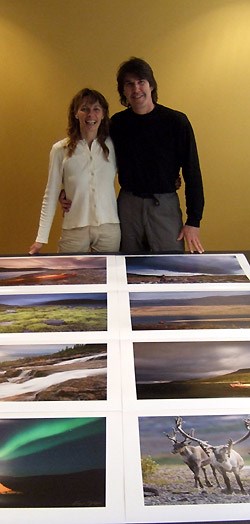Gary and Joanie McGuffin are bound for the Smithsonian Institution in Washington, D.C.
Photographs by Goulais River's best-known adventurers last fall on the George River in northeastern Quebec will become part of a Visions of the Boreal Forest Exhibition that will open at the Smithsonian's National Museum of Natural History in 2008.
SooToday.com caught up with the McGuffins recently when they picked up the eight large prints of their work printed by Sault Ste. Marie's Lucidia Studios.
Last September, the McGuffins and fellow consevrationist Robert Mullen led a group of 12 on an 18-day, 225-kilometre adventure from Indian House Lake on the George River to Helen's falls, a couple dozen kilometres south of Ungava Bay in Nunavik.
"It's one of the most remote rivers to canoe in North America," said Gary McGuffin. "We wanted them to have the experience of art and science coming together in adventure."
The group included artist/paddlers Robert Bateman, Jean-Louis Courteau, Lindsey Foggett, Jay J. Johnson, Lee Kromschroeder and John Pitcher; wilderness first aid expert Dr. James Evans as well as Smithsonian anthropologist Dr. Stephen Loring.
The McGuffins led the expedition with Mullen, a paddler, artist and conservationist, who will curate the new exhibit, which is expected to tour Ottawa, Montreal, Toronto, Vancouver, Minneapolis, Denver, San Francisco and New York. Mullen and the McGuffins decided to call last year's trip the Great Boreal River Adventure.
And an adventure it was, with frequent wildlife sightings, rugged climbs through hills crawling with enough black flies to choke a moose and beautiful, pristine wilderness, all set against a backdrop of low-slung, dramatic clouds edgy with threat of rain.
Gary McGuffin said that one of the most remarkable moments on the trip for him was when the group was discovered by a family of caribou passing through the camp to the river.
"They probably came that way almost every day and one morning they came along and there we were," he said.
McGuffin said he waved his hands in the air like antlers to coax them closer, giving him time to set up his tripod, which was packed as the paddlers were about to set off when the caribou came into camp.
He managed to shoot many photos of the startled caribou family and one of those will be going into the Smithsonian collection.
Another of the photos is of a waterfall McGuffin said only he, Lee Kromschroeder and Mullen made it up to.
"I had seen it the year before on our preparation trip," said McGuffin. "So I knew I wanted to get up there and shoot it. I just didn't realize how hard it would be."
McGuffin said the day was overcast with intermittent periods of rain and not even the gentlest breeze to brush away the black flies.
They were as thick as he's seen them.
He said the climb was steep, wet and slippery, through close clumps of alder and thick underbrush.
"We watched some of the others pull out their fishing rods to try to catch dinner as we set out," he said. "When we came out of the brush and looked down the hill it was all worth it."
Two years ago Mullen launched the Wilderness River Art Foundation, host organization for this wilderness art adventure program.
They'll be leading another adventure shortly - a paddle along the north shore of Lake Superior, about the same time as the opening of the first preview of art inspired by the Great Boreal River Adventure.
Visions of the Boreal Forest: Artists Deep in the Northern Wilderness runs at The Wildling Art Museum in Los Olivos, California from June 27 to September 9.
The McGuffins are thrilled about the upcoming opportunity to combine art and science with adventure in the boreal forest on the world's largest freshwater lake.
They hope it will raise awareness of the threats to this ecosystem, one Gary McGuffin says functions as the primary lungs of the planet and an effective carbon sink.
The McGuffins are thrilled about the many opportunities presented by the Smithsonian exhibit.
"Art is just a way to draw people in," says Gary. "Then you draw attention to the boreal forest. It's about the forest and it's about the threats to the forest."
McGuffin said the boreal forest ecosystem is the largest intact forest on Earth and half of the Lake Superior watershed is in the boreal forest.
"The boreal forest is critical for climate, water, habitat, native culture, timber, minerals and energy," he said. "But it's very accessible, underappreciated and gravely threatened."
"There are a lot of superlatives to it," McGuffin said. "And it's threatened by unsustainable development making it one of the greatest and most pressing conservation opportunities in the world."
